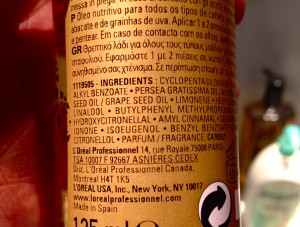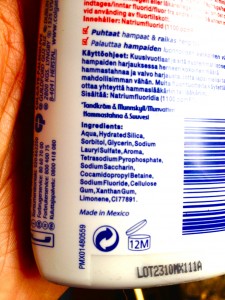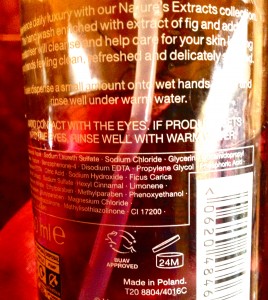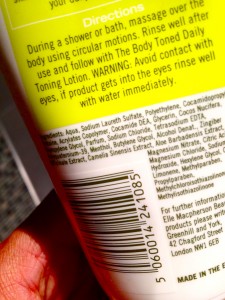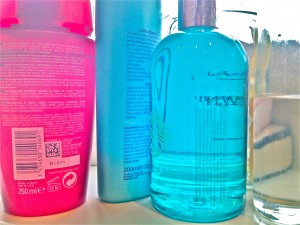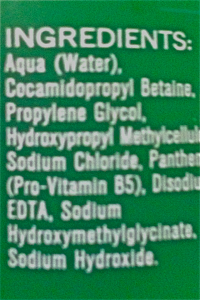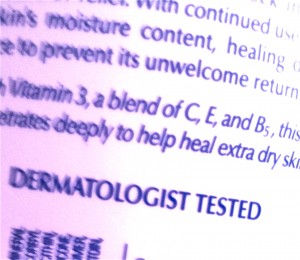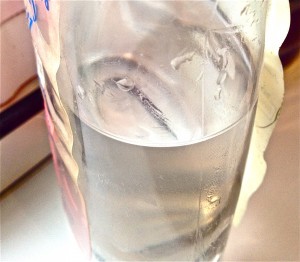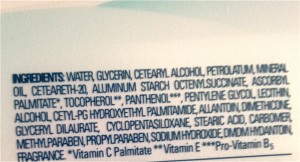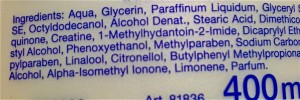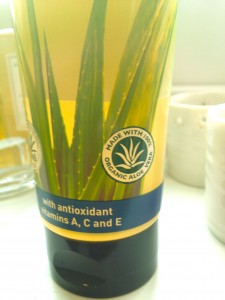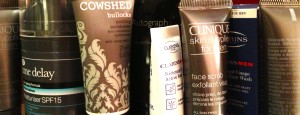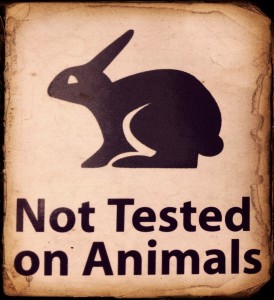There’s more…!
We are discussing the potential or possible dangers inherent in the skin care products we use. Protesters claim that on average a person may use 9 or 10 products in a day and often more. This ‘bioaccumulation’ of potential threat is the subject of these posts, and the puzzle of what is really to fear in these products…if anything…
These are a few of the ingredients people have asked me about since the last post…
Fragrance
Some people may want their products to be ‘fragrance-free’, ‘unscented’ or ‘unperfumed’. They may want the product but not like the chosen smell, or simply not want the scent to clash with their preferred signature perfume, but more often than not it is due to concerns regarding allergies. Many people think of their skin as sensitive (reacting as itchy, flaky or reddening) but it may well be the perfume in the products (both natural and synthetic) they use that is actually the problem. Brands add perfume, not only for the point of sale benefit (they know people often buy with their noses as-it-were), but to mask the smell of the base ingredients (both natural and synthetic) which might not be conducive in quite the same way! So, be aware that there is a possibility that those products marketed as unperfumed or unscented are not actually free of the fragrance compounds that may be be causing an allergy.
Any added fragrances are found in the ingredient list and identified by the inclusion of the word ‘parfum’. The warnings can also be applied to essential oils as they can be equally strong smelling but also contain the same natural constituents as the fragrances which would therefore trigger the same allergies if you are prone.
Bergamot oil is a case in point as it can react with sunlight and irritate skin.
Phthalates
There are phthalates in literally thousands of products. They are essentially a group of esters that are used to increase the flexibility, transparency and durability of another substance and are used a lot in conjunction with plastics. Obviously, not all phthalates are the same but the general grievance against them is that in laboratory tests they are thought to mimic hormones when they enter the body and disrupt the nervous and reproductive systems and recent research has suggested a link to an increase in diabetes in women and a general link to increased obesity. There are too many variations and purposes to list here as the area we are interested in is their use in cosmetic and personal care products.
Phthalates are often used in the packaging of products but the most common use is as part of a ‘fragrance’ and so it is not necessarily listed on the packaging as it is a component. If you see the word ‘fragrance’ then it’s likely that phthalates are in the mix (they’re actually there to render the alcohol undrinkable (!) as well and prolong the smell). It’s not easy to know which products contain it and, of course, they are not listed as ‘phthalates on the packaging but as their compound names. DEP (diethyl phthalate) is the only one actually allowed by the EU…but (there’s always a ‘but’ isn’t there?!?) the SCCS has acknowledged that there migh be traces of the other types of phthalate in a product cross contaminated from it’s packaging…and adds that, although these other phthalates are banned due to their confirmed dangers, up to some unfathomably blah blah parts per million it’s peachy. That’s not the technical term but pretty much what they are implying…
You’ll find DEP in deodorants, hair products, perfumes, after shaves, skin care products and make-up. The SCCS (Scientific Committee on Consumer Safety) considers it totally safe (it’s reviewed it twice due to pressure about concerns but each time been convinced it is safe), but there are many groups seriously concerned about it’s bioaccumulation in our bodies especially as it is in so many different products (entering the skin joined to penetration enhancers (I know, I know…) like propylene glycol for example or inhalation – no, not like glue sniffing but just as a by-product of spraying your fave perfume for example and wafting through it as you’re supposed to…) It may well be safe in tests on a single product with a moderate use but what about multiple products used by the same person on a daily basis…?
A criticism of the brands is that they just use words like ‘fragrance’ and ‘parfum’ to indicate the presence of some form of scent but ‘hide’ that fact there are phthalates within this cover all wording. This umbrella term is sanctioned by the EU and is not therefore considered to be sneaky. Brands that do not include phthalates like to list everything on their ingredients list…just to prove a point. That’s fine with me, I like the extra assurance…
Sulphates
I must confess that I have seen the word sulphates (or sulfates as our America cousins insist) loads of times and never really paid it much mind except to caution those who colour treat their hair (or chemically straighten) against shampoos with it in. I blithely extol the dangers of using these shampoos waxing lyrical about how they strip the hair and so on (actually very useful if you’ve had a home dye disaster and need to take the shade down a few notches…), but never wondered about any further dangers. I suppose I have always assumed that with the correct formulation (added humectants to counteract the drying and over efficient cleansing ability of sulphates) then there’s nothing to concern myself about. My hair is very forgiving (for a dead thing) and so…
Then I suddenly see now that there are a gajillion articles damning sulphate to hell and beyond. Yikes. So what’s the crack? Technically a sulphate is a salt of sulphuric acid (like plaster of Paris – stay with me on this) but it’s used in the beauty industry (!) is as a ‘surface active agent’ or surfactant. They essentially dissolve dirt, create a right crazy foam-on (no one loves rich lathers more than the product buying public), and prevent oils and dirt from doing anything but being washed away. It is two specific sulphates that are under attack. SLS (sodium lauryl sulphate) and SLES (sodium laureth sulphate) – there is an actual coconut derived version (sodium coco sulphate) that is often used by ‘natural’ brands but although SLS originates from coconuts it’s anything but natural. The plot thickens when it is revealed that often two different chemicals are added to the ingredients which when combined in water are effectively SLS but can allow the product to be labelled ‘free from…’ etc. Oh, the sneaky beggars…!
Much sulphate bashing seems to stem from an email and subsequent rumour that has grown to urban myth proportions, but has never been substantiated, and that is that these sulphates cause cancer. I’ve found nothing in any research showing any link to cancer but there are a number of studies that show at high concentrations those with sensitive skin may find them to be a mild irritant. Again the bioaccumulation is the concern. They are aggressive cleansers though so if there is a warning then that’s clearly it. Go gentle if you’ve got sensitive skin and avoid it if you colour or chemically straighten your hair. It is also in toothpaste and, as a known skin irritant, that’s maybe not such a good look for the inside of your mouth, plus advice is against ingesting it so I guess don’t swallow it…?!
The only other issue I can turn up is that the sulphates effect the way the skin naturally sloughs off its dead skin cells meaning that they may fall of in clumps (not like a zombie…!) It’s still minuscule but not the natural process so maybe the bioaccumulation over years means there’s an issue?
Hmmm…
The other issue seems to be fears over cross contamination of the SLS and SLES with 1,4-dioxane…
1,4-dioxane
1,4-dioxane is a chemical that is a by-product made during the process that creates SLES, for instance, (also ALS and various PEG’s, ‘-eth’s’ and ‘oxynol’s’) and is left behind in the product (cannot be ‘reasonably removed’…well, most is but some remains basically…) In tests it is shown to be a skin irritant, cause damage to the liver and kidney and cause some types of cancer. Although I should stress that it seems this is only at levels that we wouldn’t be exposed to in our daily routines…except for bioaccumulation?!? Anyhoo…actually, both UK and EU regulations do not allow the use of this substance. It cannot be knowingly added (it never is as it’s a by-product), it can be if unavoidable though (i.e. allowed to be left in) or as the CTPA (Cosmetic, Toiletry and Perfume Association) puts it:
However, unavoidable traces, even of banned substances, that cannot reasonably be removed during the manufacture of ingredients or the cosmetic product itself, are allowed as long as there is no risk to health.
Hmmm…
Lanolin
Also known as wool wax or wool fat, this soft yellow substance is secreted by the skin of the sheep to waterproof and protect their wool. It is used in moisturising and barrier creams. It is well established for its emollient properties. The issue as far as I can see is not the lanolin itself but the source of it. Commercial grade lanolin can often be from sheep that have been treated with pesticides such as DDT and lindane and these contaminate the lanolin.
Urea
Our skin contains natural moisturising elements and urea is one of these. The most effective natural humectant and is found in the epidermis (surface layer of the skin), and plays a vital role in maintaining the skin’s suppleness and moisture balance. Urea is listed as non-toxic, non-allergenic, colourless and odourless. Urea is actually the primary organic compound of urine. Mmmm. but that’s nothing to do with this as obviously a synthetic version is used in cosmetics…I hope…
When good levels of urea are present in skin it looks healthy and is supple, but when the skin is dry (and in some skin conditions such as eczema) the level of urea is reduced and this means less moisture is held to the skin and as a result it is dry, flaky and tight.
It is used often in dry skin products due to its strong moisture retaining properties but also to react with the skin’s barrier to help strengthen it, however, this process also allows other ingredients to penetrate the skin better. Urea is usually mixed with emollients and they work together to penetrate the skin and create the smooth and softness. Synthetic urea is recognised by the skin as if it were a natural version. Claims are made that the inclusion of urea means that continued use of the product will make the skin soft and have an improved texture but I see these products also tend to warn against use on acne prone skin, sensitive skin and any damaged areas…
The NHS say this about it:
‘Urea is not suitable for everyone and some people should never use it. Other people should only use it with special care. It is important that the person prescribing this medicine knows your full medical history.
Your prescriber may only prescribe this medicine with special care or may not prescribe it at all if you:
- are allergic or sensitive to or have had a reaction to any of the ingredients in the medicine
- have moist or broken skin in the area where you are planning to use Urea
Over time it is possible that Urea can become unsuitable for some people, or they may become unsuitable for it. If at any time it appears that Urea has become unsuitable, it is important that the prescriber is contacted immediately.’
Propylene Glycol (PG)
Propylene glycol is a much touted baddie in the ingredients list. Conversely it is also praised as having a long history of safe use. It is used in skin care products as a humectant (to hold water to the skin) and skin conditioning agent in a very wide range of products. ‘Its use in such products is without risk of harm to human health’ according to the CTPA. They go on to say, ‘It is often quoted that this is an ingredient used in antifreeze. This may or may not be true, but water too is a component of antifreeze. Neither fact is relevant to cosmetic safety, just as the corrosive nature of acetic acid is not relevant in its use as the food ‘vinegar’. In fact this claim about propylene glycol is often confused with ethylene glycol, which is the main constituent of common anti-freeze mixtures for motor cars.’
Hmmm.
PG is a form of mineral oil (see previous post) and comes in various grades formulated for various uses in many different products from foods, through paint and varnish to skin care. Added to its humectant strengths it is also useful as a solvent and surfactant (for foaming, keeping oils and water together etc). The issue that is raging on is that it is toxic at high levels when ingested especially and is used in many products to increase their dissolving ability, The EU is quite strict about the uses and the grade that can be allowed in food and skin care products.
Another aspect of propylene glycol that I have encountered is its use as a penetration enhancer (see previous posts about this and all previous jokes…) and the inherent dangers. I cant find any research that shows that propylene glycol at the levels it is used in products that shows it as an effective penetrator of the skin’s barrier. It seems it would have to be used over the 10% amount at which is becomes in irritant to the skin. So it would never really be practical for this use and is better by far at bonding to water to keep it on the skin.
Until this argument is lost or won the advice is to go for products with alternative ingredients, one being glycerol which is considered better as it is a natural component of the skin. Why use a foreign molecule when a more natural one (and a better hydrator) would d?…is the thought behind this recommendation.
PG is hugely researched and yet there is no conclusive, definitive, independent advice. As soon as I hear anything I’ll let you know, of course…!
Well, that’s it for now. Let me know your thoughts and ideas or any changes, further information you think is needed. Let’s go forward together and sort this puzzle out! Keep reading labels…!
And it’s always worth questioning things (isn’t it?!?) so here’s today’s conundrum…as we know that anything sold over the counter will have very little effect on the skin in the quantities allowed, will the rubbing of ‘penetration enhancers’ into our skin at least twice a day, over time, do permanent damage? After all, it is their purpose to break down the skin to allow stuff in, stuff that the skin is trying to keep out, even?
Hmmm…
To be continued…
